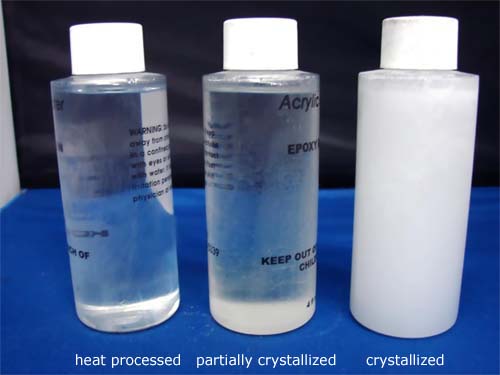View and Download Epoxy Processing Instructions: Cold Weather Notice
An epoxy resin’s physical property such as its viscosity and reactability are highly affected and influenced by temperature. Common and noticeable effects of cold temperature exposure are higher or thicker viscosity. Less accuracy in volumetric measurement due to its thicker consistency crystallized or solidified resin component will appear as a white wax-like consistency more bubble entrapment during mixing, slower reactivity, longer cure times, lower cured performance due to less homogeneous mixing. During shipping of the resin component may and can be exposed to temperatures below 50ºF and may crystallize the resin component (part A). This can be reversed with no adverse affect on its cured mechanical performance or shelf life. Simply warm the resin gently by placing it in a sealed plastic bag and immerse it in hot water or a warm room. Allow it to acclimate until it is uniformly 75ºF TO 80ºF maximum before adding the curing agent. Mixing the resin and curing agent above 80ºF will cause rapid polymerization and high exothermic heat that can exceed 300ºF in mass.
The cold temperature exposure can occur during transport or delivery of the kit were the package can be exposed to temperatures below 50°F and initiate the resin to crystallize or develop seed crystals. Once a seed crystal develops, crystallization can still occur even if stored at the proper storage temperature. Do not throw away or use the resin until it has been melted back to a free-flowing liquid phase by gentle heating 120°F to 150°F. The high purity epoxy component and the absence of any accelerators and other non-reactive impurities in its formulation are some of the many key factors that controls its high performance properties. The cold temperature will also make the resin much thicker than the stated viscosity and working time values as stated on the physical tables chart. This will reduce the polymer’s reaction rate and extend its cure time. This can rectified by pre-warming both component and using the mixed resin in a controlled temperature environment no cooler than 70°F.
An epoxy resin’s physical property such as its viscosity and reactability are highly affected and influenced by temperature. Common and noticeable effects of cold temperature exposure are higher or thicker viscosity. Less accuracy in volumetric measurement due to its thicker consistency crystallized or solidified resin component will appear as a white wax-like consistency more bubble entrapment during mixing, slower reactivity, longer cure times, lower cured performance due to less homogeneous mixing. During shipping of the resin component may and can be exposed to temperatures below 50ºF and may crystallize the resin component (part A). This can be reversed with no adverse affect on its cured mechanical performance or shelf life. Simply warm the resin gently by placing it in a sealed plastic bag and immerse it in hot water or a warm room. Allow it to acclimate until it is uniformly 75ºF TO 80ºF maximum before adding the curing agent. Mixing the resin and curing agent above 80ºF will cause rapid polymerization and high exothermic heat that can exceed 300ºF in mass.
During the colder seasons the resin and curing agent should be warmed to at least 75°F to 80°F (21°C to 27°C) prior to use to reduce its viscosity, Reduce air bubble entrapment, maintain its working time and insure proper cure. In some cases the resin or part a may appear to be cloudy or solidified, which is an indication of resin crystallization.

DO NOT USE UNLESS PROCESSED
Common and noticeable the effects of cold temperature exposure
To counter act the affects of the cold temperature exposure, warm the resin gently by placing it in a plastic bag and immerse it in hot water or a warm room and allow it to acclimate until it is a very clear and liquid in consistency allow the resin to cool 75°F to 80°F maximum before adding the curing agent.
|
Caution: Although the polymerzation has slowed due to the colder ambient conditions mixing the resin and curing agent above 80°F as it will cause rapid polymerization and high exothermic heat build-up that can exceed 300°F exothermic heat when kept in mass. Do not heat and mix the resin or curing agent beyond 90°F as it may cause rapid and uncontrollable reaction. the best working condition is to pre-warm the resin and curing agent to 70°F to 75°F prior to mixing and allow it to cure at an ambient temperature no lower than 65°F for at least 24 hours.
877-403-8008
Monday to Friday
9:00 am to 4:30 pm
polymercomposites@msn.com